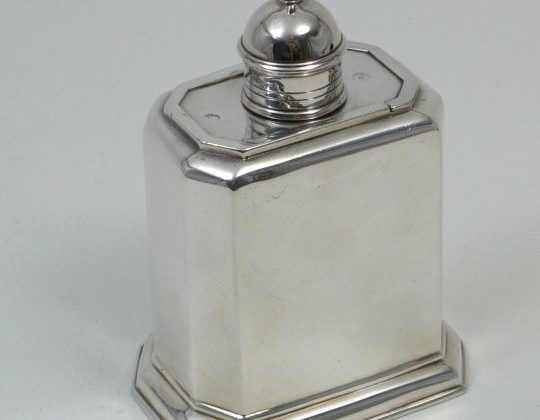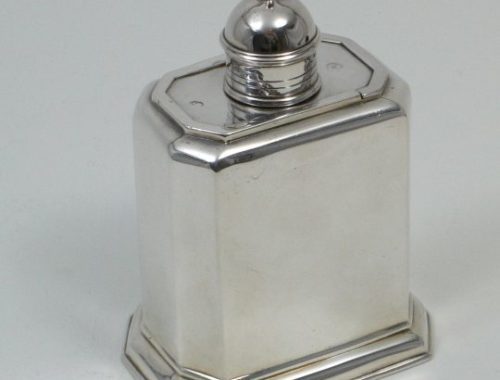Object Number: #817
London, 1713/14 (George I)
Maker: John Farnell
Hallmark: Lion’s head erased (torn off at the neck) (Jackson 1921: 84)
Sterling mark: Figure of Britannia for the Britannia Standard (Jackson 1921: 84)
Date letter: an „O“ with a half-moon in a pointed shield for 1713/14 (Jackson 1921: 84)
Maker’s mark: monogram „JF“ with a point underneath in a heart for John Farnell (Grimwade3 Nr. 1283).
Dimensions: Height: 13,5 cm (5,1 in.); width x depth: 10 x 7 cm (3,9 x 2,8 in.); weight: 230 gr.
Detailed Information
George I Silver Tea-caddy
The present silver tea caddy is a typical English, silver object from the George I period, early 18th century. The canister has a facetted, octagonal form and an embossed base and a domed cap. The surface is smooth, with no embellishment. The vertical walls are profiled on the foot and they are somehow round on the upper side of the object. The cylindrical lid has a domed cap with a cast lid knob. In order to refill the canister, the cap is slip-on and the lid is used as a measure for the tea.
The tea caddy or canister was made during the period of the Britannia Standard (1697-1720), therefore, the silver content of this object is quite high (95,84 %). The hallmarks are found underneath the base as well as partly on the slip-on cap.
Tea was during the 17th century, since circa 1680, imposed in Europe. The necessity to store tea in a dark and dry place, in order to keep its aroma, has resulted in the development of the closing tea caddy.
The tea caddies in England were usually made in sets of two, in order to keep separately the green from the black tea.
The habit of drinking tea had by the early 18th century a ceremonial character: the lady of the house prepared the tea in front of her guests. This is one of the reasons why the equipage for tea was made of silver.
Rectangular tea caddies were made mostly in England, the Netherlands, Flanders and Denmark.
This early type of tea caddy is depicted in the painting “A Family of Three at Tea” (ca. 1727), probably from the painter Richard Collins (s. Victoria & Albert Museum)
Maker
John Farnell was the son of William Farnell of Oakingham. He apprenticed to Thomas Ash 1706, and was free in 1714.
Literature
Grimwade, Ar., 1990, London Goldsmiths 1697-1837. Their marks and lives from the original registers at Goldsmiths’ Hall and other sources, GB: Faber and Faber [Grimwade3]
Gruber, Al., 1982, Gebrauchssilber des 16. bis 19. Jahrhunderts, Würzburg: Edition Popp
Jackson, Ch. J., 1911, An illustrated History of English Plate, ecclesiastical and secular in which the development of form and decoration in the Silver and Gold Work of the British Isles form the earliest known examples to the latest of the Georgian Period, Bd. II, Plauen i. Vogtl.: C.F. Schulz & Co.
Jackson, Ch., J., 1921, English Goldsmiths and their marks, London: MacMillan and Co. Limited
Schroder, T., 1988, English Domestic Silver, 1500-1900, London: Viking/The National Trust



